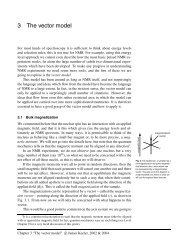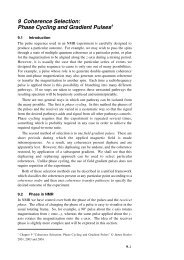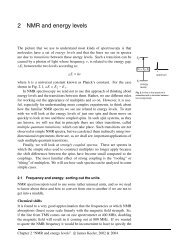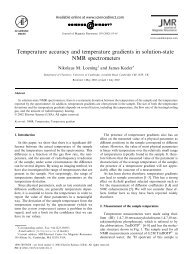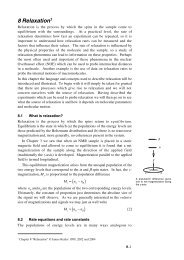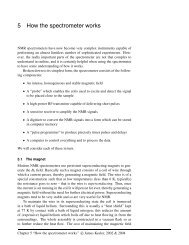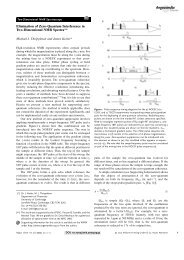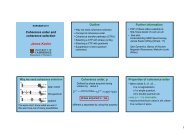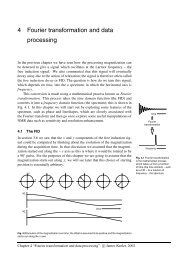Chapter 6: Product operators - The James Keeler Group
Chapter 6: Product operators - The James Keeler Group
Chapter 6: Product operators - The James Keeler Group
- No tags were found...
Create successful ePaper yourself
Turn your PDF publications into a flip-book with our unique Google optimized e-Paper software.
and z-components of the magnetization are represented by the spin angularmomentum <strong>operators</strong> I x, I yand I zrespectively. Thus at any time the state of thespin system, in quantum mechanics the density operator, σ, can be representedas a sum of different amounts of these three <strong>operators</strong>σ()= t atI () x+ btI () y+ ctI () z<strong>The</strong> amounts of the three <strong>operators</strong> will vary with time during pulses and delays.This expression of the density operator as a combination of the spin angularmomentum <strong>operators</strong> is exactly analogous to specifying the three components ofa magnetization vector.At equilibrium the density operator is proportional to I z(there is only z-magnetization present). <strong>The</strong> constant of proportionality is usually unimportant,so it is usual to write σ eq= I z6.1.2 Hamiltonians for pulses and delaysIn order to work out how the density operator varies with time we need to knowthe Hamiltonian (which is also an operator) which is acting during that time.<strong>The</strong> free precession Hamiltonian (i.e. that for a delay), H free, isH free= ΩI zIn the vector model free precession involves a rotation at frequency Ω about thez-axis; in the quantum mechanical picture the Hamiltonian involves the z-angularmomentum operator, I z– there is a direct correspondence.<strong>The</strong> Hamiltonian for a pulse about the x-axis, H pulse, isHpulse, x= ω 1Ixand for a pulse about the y-axis it isHpulse, y= ω 1IAgain there is a clear connection to the vector model where pulses result inrotations about the x- or y-axes.6.1.3 Equation of motion<strong>The</strong> density operator at time t, σ(t), is computed from that at time 0, σ(0) , usingthe following relationshipσ()= t exp( −iHt) σ( 0) exp( iHt)where H is the relevant hamiltonian. If H and σ are expressed in terms of theangular momentum <strong>operators</strong> if turns out that this equation can be solved easilywith the aid of a few rules.Suppose that an x-pulse, of duration t p, is applied to equilibriummagnetization. In this situation H = ω 1I xand σ(0) = I z; the equation to be solvedisσ( tp)= exp( −iω1tpIx) Iz exp( iω1tpIx)Such equations involving angular momentum <strong>operators</strong> are common iny6–3



